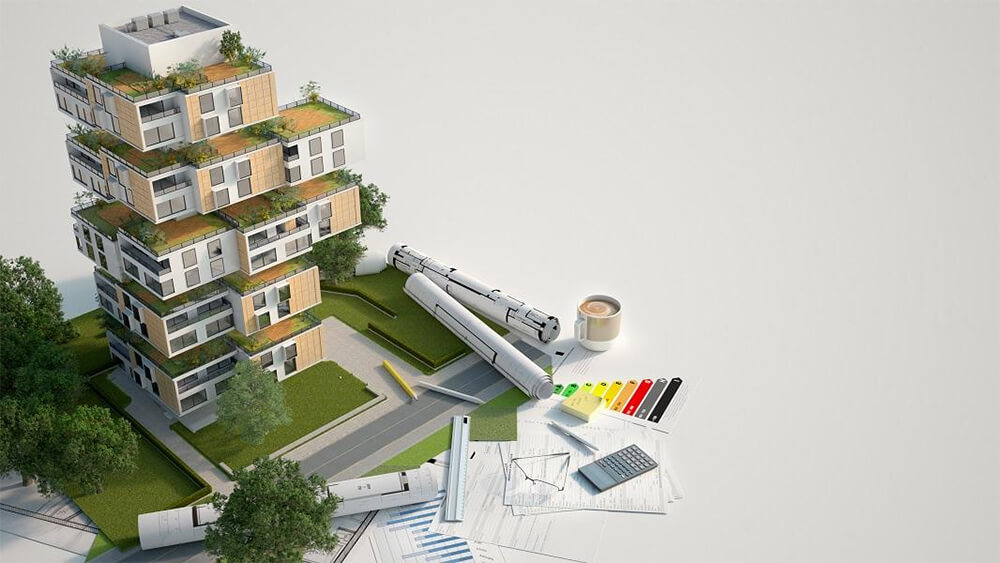Building materials can be notoriously expensive and unsustainable. Oftentimes, old, used byproducts of buildings and construction projects end up in landfills and contribute to the ever-growing pile of man-made waste. However, as sustainability is brought more and more to the forefront of the construction industry, builders and production companies are looking for more energy-efficient and environmentally-friendly products to replace what has been used in the past.
Contents
1. Concrete
Concrete is one of the sturdiest and most sustainable building materials to exist. As time goes on, concrete actually gets stronger and stronger. Because it is derived predominantly from limestone, one of the most abundant raw materials on earth, it is currently at no risk for reducing a finite resource. It has been revered by many building professionals because of its energy-efficient composition. It is fairly good at maintaining the internal temperature of the air enclosed within it, thus making it an environmentally friendly building option. Additionally, it can be broken down and reused over and over again, for both new builds and entirely different projects.
2. Reclaimed Wood
Reclaimed wood is also known as recycled wood and is often wood that gets reused after being discarded from a previous project. Not only is it aesthetically pleasing, but reclaimed wood is an excellent way to extend the life of a previously used resource. It carries a much lower environmental footprint than harvesting timber. It can be used in home building for support, or it can be used for aesthetic design purposes in benches, murals, chairs, tables, or ceiling beams. However, when looking to reuse reclaimed wood, it is best to consult an expert to ensure that the wood is still structurally sound and can be safely used in building a home or other building.
3. Bamboo
Hardwood floors have been a staple in households for many years. But the wood production needed to gather such large amounts of timber can be both costly and devastating to the environment. Bamboo is a promising substitute for a variety of reasons. Not only does it have a strikingly similar appearance to hardwood, but it has a much quicker harvest cycle. Harvest cycles are defined as the time it takes for the plant or tree to go back after it has been chopped down. Traditional wood has a harvest cycle of 25 years, which is why deforestation is so widespread. The trees don’t have enough time to grow back before others grow back. Bamboo has a harvest cycle of 3 years, giving trees more time to repopulate before more are chopped down.
4. Recycled Steel
Recycled steel is known for its immense strength, making it a popular framing and building choice. It holds up better to extreme winds, storms, and other major weathering than other options. However, there is more to recycled steel than just its sturdiness. Steel is one of the most recycled materials in the world. In fact, 2 out of 3 pounds of steel is recycled and it produces lower CO2 emissions than new steel. Recycling previously used materials is generally the preferred choice for sustainable building. A house that would normally take 40 to 50 trees to build can take only 6 six scrap cars worth of steel.
5. 3D Printing
3D printing homes and other buildings may seem very far-fetched. But the technological advances that are being made in the world of 3D printing have pushed to the forefront of potential sustainable building materials. There are construction companies that are currently experimenting with printing almost fully constructed homes and buildings. Because you have to program the computer print, you know exactly how many materials are needed. This reduces massive amounts of building waste. In traditionally built homes, there are up to 8,000 pounds of excess waste that could have been avoided.
The Bottom Line
The construction industry is booming. There is no shortage of homes and buildings being built. And with that, there is a lot of waste and carbon emissions that come with it. Opting for sustainable building materials when looking to construct a home or building can save both money and precious resources. Using more environmentally friendly options can result in less energy, water, and material consumption. Whether it is for an entire build or just an accent piece, choosing these materials can help make a positive impact on the environment.




